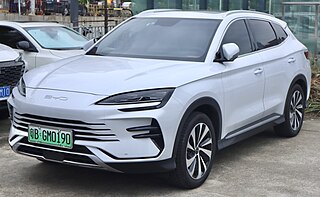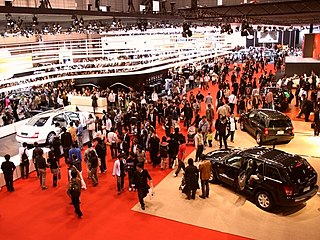
Škoda Auto a.s., often shortened to Škoda, is a Czech automobile manufacturer established in 1925 as the successor to Laurin & Klement and headquartered in Mladá Boleslav, Czech Republic. Škoda Works became state owned in 1948. After 1991, it was gradually privatized to the German multinational conglomerate Volkswagen Group, becoming a partial subsidiary in 1994 and a wholly owned subsidiary in 2000.
The model year is a method of describing the version of a product which has been produced over multiple years. The model year may or may not be the same as the calendar year in which the product was manufactured.

The Detroit Auto Show, formerly known as the North American International Auto Show (NAIAS), is an annual auto show held in Detroit, Michigan. Hosted at Huntington Place since 1965, it is among the largest auto shows in North America, and is widely regarded as one of the automotive industry's most important events.

An auto show, also known as a motor show or car show, is a public exhibition of current automobile models, debuts, concept cars, or out-of-production classics. It is attended by automotive industry representatives, dealers, auto journalists and car enthusiasts. Most auto shows occur once or twice a year. They are important to car manufacturers and local dealers as a public relations exercise, as they advertise new products and promote auto brands. The five most prestigious auto shows, sometimes called the "Big Five", are generally considered to be held in Detroit, Frankfurt, Geneva, Paris and Tokyo. Car enthusiast communities along the historic U.S. Route 66 are credited with general popularization of car meets, including ethnic groups such as the Hispanos of New Mexico, Chicanos, and Mexican-Americans of the Southwestern United States; lowrider, high technology, electric vehicle, and other enthusiast show, are popular in Los Angeles, Las Vegas, Albuquerque, San Francisco, and Chicago for this reason.

A green vehicle, clean vehicle, eco-friendly vehicle or environmentally friendly vehicle is a road motor vehicle that produces less harmful impacts to the environment than comparable conventional internal combustion engine vehicles running on gasoline or diesel, or one that uses certain alternative fuels. Presently, in some countries the term is used for any vehicle complying or surpassing the more stringent European emission standards, or California's zero-emissions vehicle standards, or the low-carbon fuel standards enacted in several countries.

A plug-in hybrid electric vehicle (PHEV) or simply plug-in hybrid is a type of hybrid electric vehicle equipped with a rechargeable battery pack that can be directly replenished via a charging cable plugged into an external electric power source, in addition to charging internally by its on-board internal combustion engine-powered generator. While PHEVs are predominantly passenger cars, there are also plug-in hybrid variants of sports cars, commercial vehicles, vans, utility trucks, buses, trains, motorcycles, mopeds, military vehicles and boats.

The Pebble Beach Concours d'Elegance is an annual automotive event held on the Pebble Beach Golf Links in Pebble Beach, California. It is widely considered the most prestigious car show in the world and it is the pinnacle Concours d'Elegance competition worldwide.

The Japan Mobility Show (ジャパンモビリティショー), called Tokyo Motor Show (東京モーターショー) (TMS) until 2019, is a biennial auto show held in October–November at the Tokyo Big Sight, Tokyo, Japan for cars, motorcycles and commercial vehicles. Hosted by the Japan Automobile Manufacturers Association (JAMA), it is a recognized international show by the Organisation Internationale des Constructeurs d'Automobiles, and normally sees more concept cars than actual production car introductions, which is the reason why the automotive press sees the show as one of the motorshow's big five.

The D.C. Armory is an armory and a 10,000-seat multi-purpose arena in the eastern United States, located in Washington, D.C., east of the U.S. Capitol building. Managed by the Washington Convention and Sports Authority, the Armory was constructed and opened in 1941, as the headquarters, armory, and training facility for the District of Columbia National Guard. In recent years it has also become a venue for a broad range of events. Adjacent to the northeast is RFK Stadium, which opened in 1961.

The Canadian International AutoShow (CIAS) is Canada's largest auto show. This event has been held in Toronto, Ontario, since 1974 and is staged annually in February at the Metro Toronto Convention Centre. It draws an average of 300,000 visitors throughout its showing from Ontario and Western New York.
The Salón Internacional del Automóvil México or simply SIAM was an annual auto show held at the Banamex convention center of the Hipódromo de las Américas racecourse in Mexico City, Mexico. Planned as a successor to the Auto Expo del Automóvil it spanned only three editions from 2004 to 2006.
In the United States automotive industry, the term Big Three is used for the country's three largest motor vehicle manufacturers, especially indicating companies that sell under multiple brand names.

Roewe is an automotive brand owned by the Chinese automaker SAIC Motor since 2006. Roewe vehicles were initially based on technology acquired from defunct British carmaker MG Rover. SAIC was unable to purchase the rights to the Rover brand name and created the Roewe marque as a replacement. Roewe vehicles are sold in most export markets outside China under the MG marque.
The Manila International Auto Show is a yearly show for car buyers and enthusiasts alike to look, observe and learn more at the latest models and significant concepts from the Philippines’ premiere auto makers. It is the Philippines’ biggest motor show in terms of visitor count, cars on display, and exhibitors. The show was previously known as The Manila International Motor Show,

Driven To Perform (DTP) is an auto show billed as Western Canada's largest and most established automotive lifestyles tour and originally featured mainly import tuner sport compact cars. The inaugural show was held in Vancouver, BC in 2002 as Import Showoff Canada, but has since changed its name and expanded to include other vehicle types and into the other large metropolitan cities in this region of Canada. Major sponsors include Toyo Tires, Future Shop, Mobil 1, Honda, Mazda, Lordco and Visions Electronics.

The Tokyo Auto Salon is an annual auto show held in January at the Makuhari Messe, Chiba City, Japan for Performance and custom aftermarket parts and technology displays. Hosted by the Nippon Auto Parts Aftermarket Committee (NAPAC), the Tokyo Auto Salon is one of the top motor shows globally for modified and tuned cars. The 2019 Tokyo Auto Salon featured 906 vehicles, 426 exhibitors, and 4,175 booths that offered aftermarket accessories for purchase. There are also after-market parts manufacturers, custom shops, care manufacturers, automotive businesses, and automotive vocational schools. There are not only custom cars and after-market manufacturers, there is also live entertainment. Top musicians from around the world and talk shows hosting famous drivers and celebrities can be seen at the Tokyo Auto Salon.
Mitsubishi Motors concepts are the prototype and concept cars exhibited around the world by Mitsubishi Motors. In common with other automakers, Mitsubishi has used concept cars as both show cars—stylistically adventurous motor show exhibits with no production intentions behind them—or as precursors of future models destined for mass production.
Toyota concept vehicles are transportation devices manufactured or designed by automobile company Toyota from 2000 to 2009. As their name suggests, these vehicles were concepts, and, as such, many were never released to dealerships. Many were developed in conjunction with other corporations such as Sony or Subaru.
This article provides an overview of the automotive industry in countries around the world.

The Green Car Vision Award is an annual award granted by the Green Car Journal. In contrast with its Green Car of the Year award, which only considers production vehicles that make the most significant environmental advancements, the Green Car Vision Award considers pre-production vehicles with more than one functional prototype in existence and that may be in the early stages of commercialization. Vehicles that are part of a demonstration fleet or other program that finds them regularly driven by people other than employees of their manufacturer may also be considered. Nominees may also include a modification of an existing vehicle model, such as a conversion to another type of power like electric drive.















